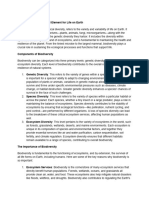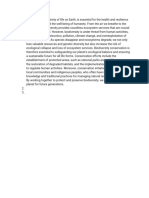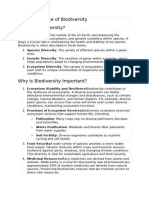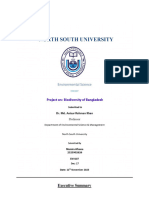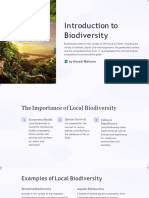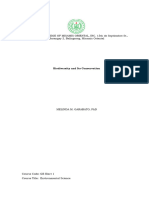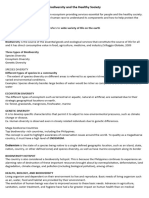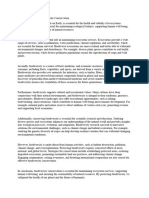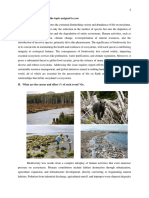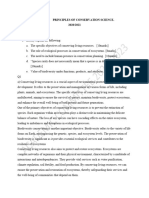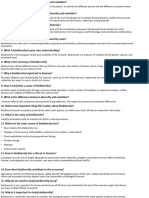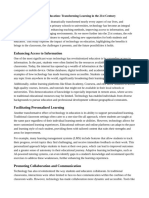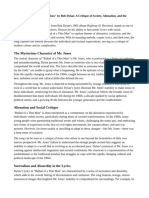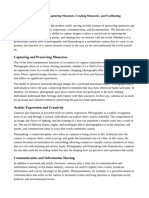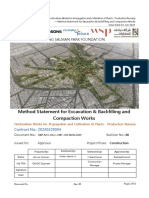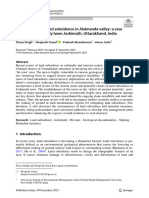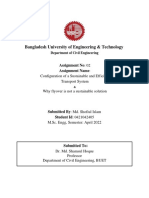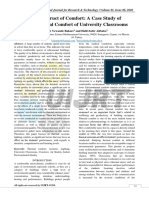whatever
whatever
Uploaded by
Τάκης ΠρεφτίτσηςCopyright:
Available Formats
whatever
whatever
Uploaded by
Τάκης ΠρεφτίτσηςCopyright
Available Formats
Share this document
Did you find this document useful?
Is this content inappropriate?
Copyright:
Available Formats
whatever
whatever
Uploaded by
Τάκης ΠρεφτίτσηςCopyright:
Available Formats
The Importance of Biodiversity: A Key to a Sustainable Future
Biodiversity, the variety of life on Earth, plays a crucial role in maintaining the balance of ecosystems
and ensuring the survival of all living organisms. From the smallest microbes to the largest mammals,
each species plays a part in the intricate web of life. As human activities increasingly disrupt natural
habitats and threaten species with extinction, the importance of biodiversity has never been more
critical. This essay explores the significance of biodiversity, the threats it faces, and the need for its
preservation for the health of the planet and future generations.
What is Biodiversity?
Biodiversity refers to the variety of life forms found in a specific habitat or across the planet. It
includes three main components: genetic diversity (the variety of genes within a species), species
diversity (the variety of species within an ecosystem), and ecosystem diversity (the variety of
ecosystems found in different environments). These elements work together to create a resilient and
stable environment where each species, no matter how small, contributes to the functioning of the
whole ecosystem.
Biodiversity is essential because it supports the processes that maintain life on Earth. From the oxygen
we breathe to the food we eat, our well-being depends on the complex relationships between organisms
in nature. Plants produce oxygen through photosynthesis, animals pollinate crops, and microorganisms
break down organic matter to recycle nutrients. Without a diverse range of species, these vital processes
would collapse, threatening all life on Earth.
The Role of Biodiversity in Ecosystem Services
One of the most important functions of biodiversity is its contribution to ecosystem services, the
benefits that humans derive from natural ecosystems. These services are divided into four categories:
provisioning, regulating, cultural, and supporting.
1. Provisioning Services: Biodiversity provides resources such as food, clean water, medicinal
plants, and raw materials like timber and fibers. For instance, forests provide timber for
construction, and wetlands supply water and act as natural filtration systems. Additionally,
many pharmaceutical drugs are derived from plants and animals, underlining the critical role of
biodiversity in human health.
2. Regulating Services: Diverse ecosystems regulate vital natural processes, such as climate,
water cycles, and disease control. For example, wetlands act as natural sponges, absorbing
excess water and reducing the risk of flooding. Coral reefs, with their rich biodiversity, protect
coastal areas by reducing the impact of storms and erosion.
3. Cultural Services: Biodiversity contributes to cultural and recreational values, such as tourism,
spiritual significance, and educational opportunities. Many indigenous cultures around the
world rely on the natural environment for their traditions and way of life. National parks and
wildlife reserves also attract millions of tourists, generating economic benefits while fostering a
greater appreciation for nature.
4. Supporting Services: Biodiversity supports the processes that make all other ecosystem
services possible. Soil formation, nutrient cycling, and pollination are fundamental services that
depend on healthy biodiversity. Without these, crops wouldn’t grow, and ecosystems would fail
to thrive.
The Threats to Biodiversity
Despite its importance, biodiversity is under significant threat from human activities. The main threats
to biodiversity include habitat destruction, climate change, overexploitation, pollution, and invasive
species.
1. Habitat Destruction: Deforestation, urbanization, agriculture, and mining are major drivers of
habitat destruction. As natural habitats are destroyed, species lose their homes, leading to
declines in populations and extinction. Forests, wetlands, and coral reefs are some of the most
affected ecosystems, with entire species losing their habitats due to human encroachment.
2. Climate Change: The changing climate is altering ecosystems and the distribution of species.
As temperatures rise, many species are forced to migrate to cooler areas, while others face
extinction if they cannot adapt quickly enough. Ocean acidification, caused by increased carbon
dioxide levels, is threatening marine biodiversity, particularly coral reefs, which rely on a stable
environment to survive.
3. Overexploitation: The overharvesting of natural resources, such as fishing, hunting, and
logging, puts immense pressure on ecosystems and species. Overfishing, for example, depletes
fish populations, disrupting marine ecosystems. Similarly, illegal poaching and the trade in
endangered species further threaten biodiversity.
4. Pollution: Pollution, particularly plastic waste and chemical contaminants, has devastating
effects on wildlife. Chemicals can contaminate water sources, harm aquatic life, and disrupt
reproductive processes. Air pollution can damage forests, and soil pollution can reduce
agricultural productivity and harm soil organisms, essential for plant growth.
5. Invasive Species: The introduction of non-native species to new environments can disrupt local
ecosystems. Invasive species often outcompete native species for resources, leading to the
decline of native populations and the alteration of ecosystem functions. For example, the spread
of invasive plants in wetlands can lead to a loss of biodiversity, as they often crowd out native
species.
The Importance of Conservation
Given the critical role biodiversity plays in sustaining life on Earth, it is essential to prioritize its
conservation. Biodiversity conservation helps protect ecosystems, ensuring that they continue to
provide the services that humans rely on. There are several strategies for conserving biodiversity,
including:
1. Protected Areas: Establishing national parks, nature reserves, and marine protected areas helps
safeguard ecosystems and species from human exploitation. These areas allow species to thrive
in their natural habitats while promoting eco-tourism and education.
2. Sustainable Practices: Promoting sustainable agriculture, fishing, and forestry practices helps
reduce the impact of human activities on biodiversity. For instance, organic farming and
sustainable fishing methods can help maintain ecosystem health and prevent species loss.
3. Restoration Efforts: Restoration projects, such as reforestation and wetland rehabilitation, help
restore ecosystems that have been degraded. These projects aim to reintroduce native species,
improve soil quality, and restore the natural balance of ecosystems.
4. Education and Advocacy: Raising awareness about the importance of biodiversity and the
threats it faces is crucial for building public support for conservation efforts. Educating
communities about sustainable practices and the value of biodiversity helps foster a culture of
environmental stewardship.
5. International Cooperation: Biodiversity loss is a global issue that requires international
cooperation. The Convention on Biological Diversity (CBD) is an international treaty aimed at
conserving biodiversity, promoting its sustainable use, and ensuring fair and equitable sharing
of the benefits derived from genetic resources.
Conclusion
In conclusion, biodiversity is fundamental to the health of our planet and the well-being of all living
organisms. It provides critical ecosystem services, supports food security, promotes climate stability,
and enhances cultural and recreational values. However, human activities have put biodiversity under
unprecedented pressure, threatening the survival of species and ecosystems. It is essential that we take
immediate action to conserve biodiversity through protected areas, sustainable practices, restoration
efforts, education, and international cooperation. By doing so, we can ensure a more sustainable and
prosperous future for generations to come.
You might also like
- Untitled documentDocument3 pagesUntitled documentvampystringNo ratings yet
- The Importance of Biodiversity Conservation For Environmental SustainabilityDocument4 pagesThe Importance of Biodiversity Conservation For Environmental SustainabilityRaj 147No ratings yet
- The Importance of Biodiversity ConservationDocument4 pagesThe Importance of Biodiversity ConservationFern Andrei RoselloNo ratings yet
- Importance of Biodiversity ConservationDocument4 pagesImportance of Biodiversity Conservationanuragsenapati48No ratings yet
- Biodiversity and Conversation (Done)Document3 pagesBiodiversity and Conversation (Done)MarieNo ratings yet
- Lesson 4 5Document8 pagesLesson 4 5jeffbacho889No ratings yet
- BIODIVERSITYDocument4 pagesBIODIVERSITYCris TineNo ratings yet
- Unit V - (EVS) BiodiversityDocument10 pagesUnit V - (EVS) Biodiversitypanthers82638No ratings yet
- The Importance of BiodiversityDocument1 pageThe Importance of BiodiversityIsmael ReyesNo ratings yet
- Biweekly - Biodiversity and Its ConservationDocument11 pagesBiweekly - Biodiversity and Its ConservationPriyanka SharmaNo ratings yet
- BiodiversityDocument42 pagesBiodiversityEnitsuj Eam EugarbalNo ratings yet
- School NotesDocument1 pageSchool NotesHumanNo ratings yet
- STS Finals ReviewerDocument7 pagesSTS Finals Reviewerdecalcomanie.egoNo ratings yet
- STS Finals' ReviewerDocument17 pagesSTS Finals' Reviewerdecalcomanie.egoNo ratings yet
- Rimjhim23583080EVS (1)Document7 pagesRimjhim23583080EVS (1)rimjhim283No ratings yet
- Biodiversity Conservation in IndiaDocument20 pagesBiodiversity Conservation in Indiaadeeba showkatNo ratings yet
- Biodiversity Threats and Conservation (Kashish&group)Document26 pagesBiodiversity Threats and Conservation (Kashish&group)kashish chetnaniNo ratings yet
- 01Document3 pages01mishti.s.8385No ratings yet
- BiodiversityDocument2 pagesBiodiversityAndrei BazarincaNo ratings yet
- Module II Environmental-ScienceDocument27 pagesModule II Environmental-ScienceKrizel Joyce C. NullarNo ratings yet
- Biodiversity: Life To Our Mother EarthDocument19 pagesBiodiversity: Life To Our Mother EarthAnil KumarNo ratings yet
- Executive Summary 1Document8 pagesExecutive Summary 1Sadman Sharar 1931037030No ratings yet
- Be A Part of The Plan KAVYA - EditedDocument3 pagesBe A Part of The Plan KAVYA - EditedPiyush GoyalNo ratings yet
- Environmental Science AssignmentDocument8 pagesEnvironmental Science AssignmentsambitNo ratings yet
- Introduction To BiodiversityDocument8 pagesIntroduction To BiodiversityTanishq AnandNo ratings yet
- EcosystemsDocument34 pagesEcosystemsauroraepiclolNo ratings yet
- Inbound 6085717682387790577Document8 pagesInbound 6085717682387790577Rhean EscobidoNo ratings yet
- 8 Main Values of Biodiversity - ExplaiDocument9 pages8 Main Values of Biodiversity - ExplaiDiju ChoudhuryNo ratings yet
- Chapter 4 BiodiversityDocument20 pagesChapter 4 Biodiversitytasdidtawhid123No ratings yet
- Loss of BiodiversityDocument6 pagesLoss of BiodiversityApple VillegasNo ratings yet
- The Importance of BiodiversityDocument1 pageThe Importance of Biodiversitykoundinya.sanathNo ratings yet
- EvsDocument17 pagesEvsdd3613667No ratings yet
- Nature's Symphony Harmony in DiversityDocument2 pagesNature's Symphony Harmony in Diversityedrian.estpi11No ratings yet
- Resume pdf-14Document1 pageResume pdf-14ittosaachiNo ratings yet
- 4Document1 page4workr285No ratings yet
- Threats To Biodiversity Loss and Climate ChangeDocument3 pagesThreats To Biodiversity Loss and Climate ChangeEmma ElardeNo ratings yet
- Biodiversity and The Healthy Society HO 1Document6 pagesBiodiversity and The Healthy Society HO 1Johoney MarceloNo ratings yet
- Untitled DocumentDocument14 pagesUntitled DocumentGaurav GNo ratings yet
- Importance of Biodiversity ConservationDocument4 pagesImportance of Biodiversity ConservationJuihal MoranhatNo ratings yet
- SCIENCE 9 - BiodiversityDocument10 pagesSCIENCE 9 - Biodiversityemanuel.ferrer.sbeNo ratings yet
- Presentation Ppt BiodiversityDocument11 pagesPresentation Ppt BiodiversityHarsha SpammzNo ratings yet
- The Importance of BiodiversityDocument2 pagesThe Importance of BiodiversityceliadessardNo ratings yet
- Biodiversity and The Healthy SocietyDocument2 pagesBiodiversity and The Healthy SocietyclaireannalariaoNo ratings yet
- The Significance of Biodiversity ConservationDocument1 pageThe Significance of Biodiversity ConservationbarteksribdNo ratings yet
- Made by Ifsita NaskarDocument29 pagesMade by Ifsita Naskarsulatanaskar24No ratings yet
- Biodiversity LossDocument5 pagesBiodiversity LossBernard Flores BellezaNo ratings yet
- C. Biology PascoDocument10 pagesC. Biology PascodelalejusticeNo ratings yet
- biodiversityDocument2 pagesbiodiversitysekolah-6328No ratings yet
- EnviSci Lesson 6 BiodiversityDocument27 pagesEnviSci Lesson 6 BiodiversityJohn Carlo De Guzman OcampoNo ratings yet
- Biodiversity Conservation: Thecla M. MutiaDocument9 pagesBiodiversity Conservation: Thecla M. Mutiahsdf,asghNo ratings yet
- Biology ProjectDocument18 pagesBiology Projectrexol67424No ratings yet
- BiodiversityDocument3 pagesBiodiversityLawrence ZviksNo ratings yet
- Importance of BiodiversityDocument53 pagesImportance of BiodiversitypaulangelomicoNo ratings yet
- Mod 5 EnvironmentDocument32 pagesMod 5 EnvironmentShane De VillaNo ratings yet
- BiodiversityDocument134 pagesBiodiversityashmitadas2784No ratings yet
- ResearchDocument4 pagesResearchjohn923perezNo ratings yet
- Title - "The Importance of Biodiversity - Exploring Earth's Web of Life"Document1 pageTitle - "The Importance of Biodiversity - Exploring Earth's Web of Life"mfabregamarinNo ratings yet
- Essay 2Document1 pageEssay 2rayyan.qurayshNo ratings yet
- GRP-2 BiodiversityDocument7 pagesGRP-2 BiodiversityRonaly HiladoNo ratings yet
- technologyDocument3 pagestechnologyΤάκης ΠρεφτίτσηςNo ratings yet
- ballad of a thin manDocument3 pagesballad of a thin manΤάκης ΠρεφτίτσηςNo ratings yet
- camera functionDocument3 pagescamera functionΤάκης ΠρεφτίτσηςNo ratings yet
- why should we read historyDocument1 pagewhy should we read historyΤάκης ΠρεφτίτσηςNo ratings yet
- Why Palestine Is in The WrongDocument6 pagesWhy Palestine Is in The WrongΤάκης ΠρεφτίτσηςNo ratings yet
- Method Statement For Excavation & Backfilling and Compaction Works, Rev. 00Document52 pagesMethod Statement For Excavation & Backfilling and Compaction Works, Rev. 00Amran HossainNo ratings yet
- joshimath land subsidenceDocument29 pagesjoshimath land subsidencegyanshankarbhartiNo ratings yet
- TQP and TQSMDocument23 pagesTQP and TQSMSalman QadirNo ratings yet
- Managing Indoor Enviroments and Energy in Buildings With Integrated Intelligent SystemsDocument269 pagesManaging Indoor Enviroments and Energy in Buildings With Integrated Intelligent SystemsAriel RiosNo ratings yet
- Decentralised, Off-Grid Solar Pump Irrigation Systems in Developing Countries - Are They Pro-Poor, Pro-Environment and Pro-Women?Document16 pagesDecentralised, Off-Grid Solar Pump Irrigation Systems in Developing Countries - Are They Pro-Poor, Pro-Environment and Pro-Women?muntasir antuNo ratings yet
- Cbmec 02 Strategic ManagementDocument19 pagesCbmec 02 Strategic ManagementMark Anthony Jr. YansonNo ratings yet
- World's General KnowledgeDocument3 pagesWorld's General KnowledgeAhsan Rao0% (1)
- Rexco 25 Chain LubeDocument4 pagesRexco 25 Chain LubePLN UPT MAKASSARNo ratings yet
- 2014 - 007 Sample Piping Layouts of A Water SupplyDocument23 pages2014 - 007 Sample Piping Layouts of A Water SupplycicpemaintenanceNo ratings yet
- Letter From Hon ParkerDocument2 pagesLetter From Hon ParkerThomas CoughlanNo ratings yet
- ESS Lifecycle AnalysisDocument4 pagesESS Lifecycle AnalysisCarlos Alberto RembadoNo ratings yet
- CEDD - Port Works Design Manual - Part 3 - Guide To Design of ReclamationDocument128 pagesCEDD - Port Works Design Manual - Part 3 - Guide To Design of ReclamationTam_Luu_77No ratings yet
- Earth DayDocument12 pagesEarth DayAnto Roldan OliveraNo ratings yet
- Nuke Myths Response To RA ArgumentDocument18 pagesNuke Myths Response To RA ArgumentDaniel VenablesNo ratings yet
- Brake Parts Cleaner WES W7341 PDFDocument11 pagesBrake Parts Cleaner WES W7341 PDFYoutube For EducationNo ratings yet
- Muet Topic 11 EnviromentDocument6 pagesMuet Topic 11 EnviromentMUHAMAD FAHMI BIN SHAMSUDDIN MoeNo ratings yet
- Script Listening Unit 7Document10 pagesScript Listening Unit 7lan thảo nguyễn thịNo ratings yet
- Assignment2Document6 pagesAssignment2Md. Shofiul Islam100% (1)
- Anh 11 HK 2 Ma de 415Document4 pagesAnh 11 HK 2 Ma de 415Lò TùngNo ratings yet
- B-1715 Boysen Acrytex Topcoat Semi-Gloss 0220Document10 pagesB-1715 Boysen Acrytex Topcoat Semi-Gloss 0220jeffNo ratings yet
- The Construct of Comfort: A Case Study of Environmental Comfort of University ClassroomsDocument5 pagesThe Construct of Comfort: A Case Study of Environmental Comfort of University ClassroomsUIJRT United International Journal for Research & TechnologyNo ratings yet
- The Ups and Downs of Population GrowthDocument2 pagesThe Ups and Downs of Population GrowthLaarni Faye SarmientoNo ratings yet
- Araç Hva temizleyici00447-RENSAIR-AirBubbl-2pp-v1.0-US-v03Document2 pagesAraç Hva temizleyici00447-RENSAIR-AirBubbl-2pp-v1.0-US-v03kripto uzmanıNo ratings yet
- Estimasi Tangkapan Per Unit Upaya Baku Dan ProporsDocument13 pagesEstimasi Tangkapan Per Unit Upaya Baku Dan ProporsYudiNo ratings yet
- A Reserach Paper On Eco Villages by RelaDocument57 pagesA Reserach Paper On Eco Villages by RelaSagar PanchalNo ratings yet
- Project Proposal on Health and Nutrition Project for School ChildrenDocument19 pagesProject Proposal on Health and Nutrition Project for School ChildrenShaik SadiqNo ratings yet
- Dissertation FinalDocument81 pagesDissertation FinalBanashree GaraiNo ratings yet
- Lubi Solar - Solar Panel Manufacturer IndiaDocument17 pagesLubi Solar - Solar Panel Manufacturer IndiaLubi Solar0% (1)
- Sustainability Reporting in The Accounting CurriculumDocument14 pagesSustainability Reporting in The Accounting CurriculumAnita NgNo ratings yet
- Symdiol 68T SDSDocument9 pagesSymdiol 68T SDSdervin.d.lopezNo ratings yet
